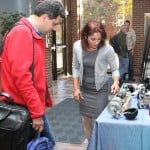 Michigan Tech students participated with other university students in an multi-year international competition to design a Portable Assisted Mobility Device (PAMD) through the Partners for the Advancement of Collaborative Engineering Education (PACE) program. There were 7 international teams and 45 universities from around the world involved, showing the “collaborative engineering” purpose of the PACE program. At the 2014 PACE Global Annual Forum in Turin (Italy) the projects were evaluated by an international team of judges including GM/Opel, Siemens, PLM Software, Autodesk, Oracle, and HP.
Michigan Tech students participated with other university students in an multi-year international competition to design a Portable Assisted Mobility Device (PAMD) through the Partners for the Advancement of Collaborative Engineering Education (PACE) program. There were 7 international teams and 45 universities from around the world involved, showing the “collaborative engineering” purpose of the PACE program. At the 2014 PACE Global Annual Forum in Turin (Italy) the projects were evaluated by an international team of judges including GM/Opel, Siemens, PLM Software, Autodesk, Oracle, and HP.
The winning PAMD team included RWTH Aachen University, TU Darmstadt (both in Germany), Michigan Technological University, the University of Cincinnati and the ITESM Estado de Mexico.
 Several examples of the diverse research at Mechanical Engineering-Engineering Mechanics department were shown at the R.L. Smith Building on Tuesday, Sept. 30. MEEM faculty and graduate students presented posters describing on-going and future research activities.
Several examples of the diverse research at Mechanical Engineering-Engineering Mechanics department were shown at the R.L. Smith Building on Tuesday, Sept. 30. MEEM faculty and graduate students presented posters describing on-going and future research activities.
Some of the examples of projects included nonlinear and autonomous vehicles research, agile ankle-foot prosthesis, an award winning portable assisted mobility device, ultra low sulfur and green diesel fuel comparison, and interdisciplinary research in geology and mechanical engineering on shock waves generated during explosive volcanic eruptions.
 Michigan Technological University researcher Reza Shahbazian-Yassar has discovered that perfection may not be all it’s cracked up to be, at least when it comes to designing materials for the next generation of lithium ion batteries. Shahbazian-Yassar investigates exotic new battery materials, which offer exotic new problems along with exciting possibilities. He hopes to turn one of those problems into an asset, with help from a $446,000 grant from the Division of Materials Research at the National Science Foundation.
Michigan Technological University researcher Reza Shahbazian-Yassar has discovered that perfection may not be all it’s cracked up to be, at least when it comes to designing materials for the next generation of lithium ion batteries. Shahbazian-Yassar investigates exotic new battery materials, which offer exotic new problems along with exciting possibilities. He hopes to turn one of those problems into an asset, with help from a $446,000 grant from the Division of Materials Research at the National Science Foundation.
MORE
 Big disasters almost always result in big power failures. Not only do they take down the TV and fridge, they also wreak havoc with key infrastructure like cell towers. That can delay search and rescue operations at a time when minutes count. Now, a team led by Nina Mahmoudian of Michigan Technological University has developed a tabletop model of a robot team that can bring power to places that need it the most.
Big disasters almost always result in big power failures. Not only do they take down the TV and fridge, they also wreak havoc with key infrastructure like cell towers. That can delay search and rescue operations at a time when minutes count. Now, a team led by Nina Mahmoudian of Michigan Technological University has developed a tabletop model of a robot team that can bring power to places that need it the most.
MORE
Michigan Technological University is well on its way to getting a $1.7 million, state-of-the-science transmission electron microscope (TEM), thanks to the National Science Foundation and a team of dedicated researchers led by Reza Shahbazian-Yassar.
“This will bring us to the forefront of electron microscopy,” said Shahbazian-Yassar, the principal investigator on the project. The new TEM will not only give researchers the ability to study atomic structure, it will also identify chemical composition with sensitivity close to a single atom.
MORE
 Tolou Shokuhfar will be investigating the inner workings of a protein that plays a key role in human health with funding from a five-year, $400,000 Faculty Early Career Development (CAREER) Award.
Tolou Shokuhfar will be investigating the inner workings of a protein that plays a key role in human health with funding from a five-year, $400,000 Faculty Early Career Development (CAREER) Award.
Shokuhfar, an assistant professor of mechanical engineering-engineering mechanics at Michigan Technological University, will study the biomolecule ferritin, which stores iron in the body in a non-toxic, mineralized form and releases it safely. In humans, ferritin serves as a buffer between iron deficiency and iron overload, and when it malfunctions, it may be involved in a number of degenerative diseases, such as Alzheimer’s and Parkinson’s.
MORE
Mo Rastgaar has received a National Science Foundation grant of nearly $500,000 to make his new artificial limb design a reality. With the five-year Faculty Early Career Development (CAREER) Award, Rastgaar, an assistant professor of mechanical engineering-engineering mechanics, will further develop his powered ankle-foot prosthesis: an artificial lower leg with the unique ability to restore amputees’ mobility and agility.
Michigan Technological University is a partner in the newly formed $148 million American Lightweight Materials Manufacturing Innovation Institute (ALMMII). The new facility, to be headquartered in the metro-Detroit area, will be part of the National Network of Manufacturing Innovation, a federal initiative to help US manufacturers become more competitive and encourage investment in the United States.
The Department of Materials Science and Engineering and the Department of Mechanical Engineering-Engineering Mechanics are leading the Michigan Tech partnership with ALMMII. MSE Chair Stephen Kampe, Associate Professor Paul Sanders, Professor Walter Milligan and Research Professor Steven Mashl will be primary participants from MSE.
 A graphene water balloon may soon open up new vistas for scientists seeking to understand health and disease at the most fundamental level.
A graphene water balloon may soon open up new vistas for scientists seeking to understand health and disease at the most fundamental level.
Electron microscopes already provide amazingly clear images of samples just a few nanometers across. But if you want a good look at living tissue, look again.
“You can’t put liquid in an electron microscope,” says Tolou Shokuhfar, of Michigan Technological University. “So, if you have a hydrated sample—and all living things are hydrated—you have to freeze it, like a blueberry in an ice cube, and cut it into a million thin pieces, so the electrons can pass through. Only then can you image it to see what’s going on.”
Research by Assistant Professor Mo Rastgaar and graduate student Evandro Ficanha (MEEM) is featured on the website of the American Society of Mechanical Engineers. See “Computer-Controlled Prosthetic Closely Matches Action of Human Legs.” The Mumbai Mirror and Science World Report both published news stories about Assistant Professor Mo Rastgaar’s (ME-EM) work with the Mayo Clinic to develop a prosthetic foot that moves like a real human foot. See The Mumbai Mirror and Science World Report for the full story.
Assistant Professor Mo Rastgaar’s work designing and building a microprocessor-controlled artificial leg has been widely publicized, with more articles like the above appearing in IEEE Spectrum,, Medical Design Online, Gizmag,CNN, UPI Science News and many more outlets. He was also interviewed for Clear Channel One’s radio program Conversations in Health Care.